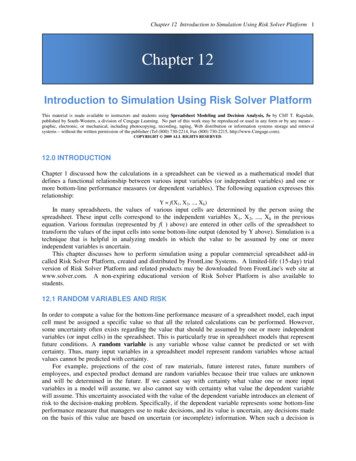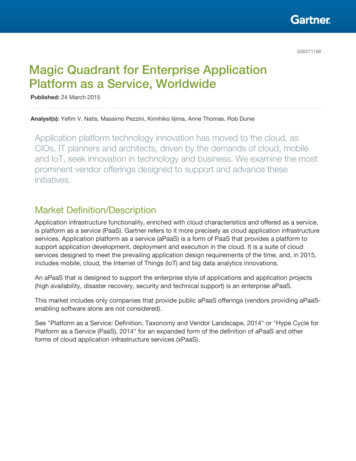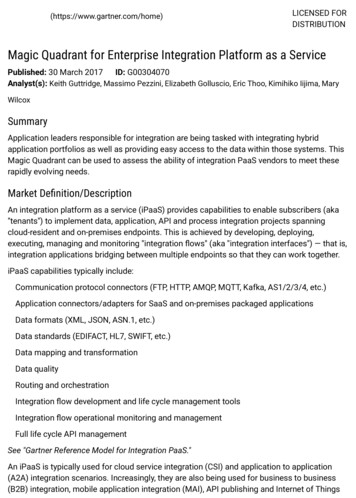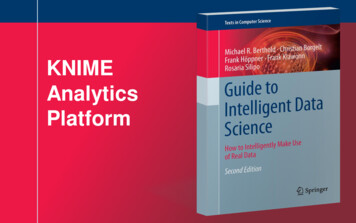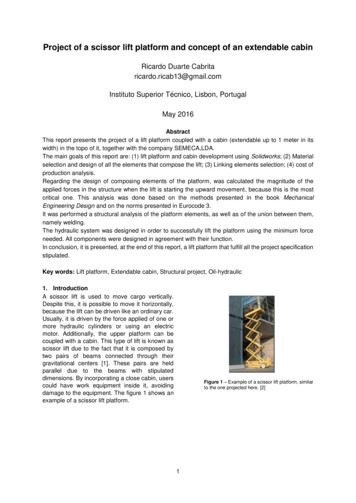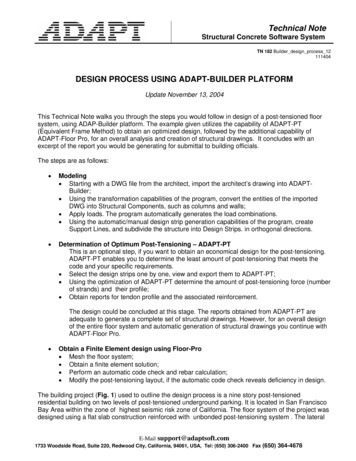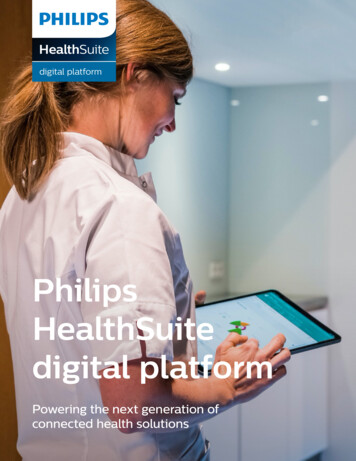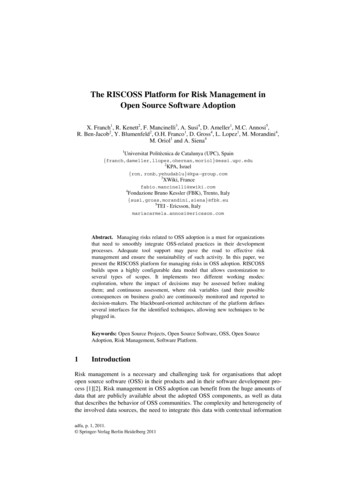
Transcription
The RISCOSS Platform for Risk Management inOpen Source Software AdoptionX. Franch1, R. Kenett2, F. Mancinelli3, A. Susi4, D. Ameller1, M.C. Annosi5,R. Ben-Jacob2, Y. Blumenfeld2, O.H. Franco1, D. Gross4, L. Lopez1, M. Morandini4,M. Oriol1 and A. Siena41Universitat Politècnica de Catalunya (UPC), upc.edu2KPA, Israel{ron, ronb,yehudablu}@kpa-group.com3XWiki, Francefabio.mancinelli@xwiki.com4Fondazione Bruno Kessler (FBK), Trento, Italy{susi,gross,morandini,siena}@fbk.eu5TEI - Ericsson, Italymariacarmela.annosi@ericsson.comAbstract. Managing risks related to OSS adoption is a must for organizationsthat need to smoothly integrate OSS-related practices in their developmentprocesses. Adequate tool support may pave the road to effective riskmanagement and ensure the sustainability of such activity. In this paper, wepresent the RISCOSS platform for managing risks in OSS adoption. RISCOSSbuilds upon a highly configurable data model that allows customization toseveral types of scopes. It implements two different working modes:exploration, where the impact of decisions may be assessed before makingthem; and continuous assessment, where risk variables (and their possibleconsequences on business goals) are continuously monitored and reported todecision-makers. The blackboard-oriented architecture of the platform definesseveral interfaces for the identified techniques, allowing new techniques to beplugged in.Keywords: Open Source Projects, Open Source Software, OSS, Open SourceAdoption, Risk Management, Software Platform.1IntroductionRisk management is a necessary and challenging task for organisations that adoptopen source software (OSS) in their products and in their software development process [1][2]. Risk management in OSS adoption can benefit from the huge amounts ofdata that are publicly available about the adopted OSS components, as well as datathat describes the behavior of OSS communities. The complexity and heterogeneity ofthe involved data sources, the need to integrate this data with contextual informationadfa, p. 1, 2011. Springer-Verlag Berlin Heidelberg 2011
related to the organisation and its ecosystem, and the convenience of combining different expertise involved in the assessment, call for adequate tools in support of all thephases of risk assessment, from data gathering, to data statistical analysis, to the correlation of these data to the organisational strategic and business risks and assets.In this paper, we present RISCOSS (www.riscoss.eu), a platform and related assessment methodology for managing risks in OSS adoption [3]. It defines severalinterfaces to a portfolio of identified measurement and risk management techniques,allowing new techniques to be plugged in if they implement these interfaces and follow well-documented protocols. RISCOSS builds upon a highly configurable datamodel that allows customization to several types of scopes to support different riskassessment perspectives. It implements two working modes: exploration, where theimpact of decisions may be assessed in advance; and continuous assessment, whererisk variables (and their consequences on business goals) are monitored, analysed andreported. This allows RISCOSS to support a holistic decision making process insidethe adopter organisation.2Related WorkSeveral long-term projects, corporate programs and research initiatives have similaraims than the approach supported by RISCOSS. In Table 1 we summarize the characteristics of the most related European projects that propose methodological approaches and tool support for measuring several aspects of OSS projects, mainly to evaluatethe quality of the OSS components and the communities behind them. In particularwe refer to the projects with objectives: FLOSSMetrics (www.flossmetrics.org): constructing, publishing and analysing alarge scale OSS database with metrics on OSS development; QualiPSO (qualipso.icmc.usp.br/OMM/): improving the quality & maturity ofOSS projects; QualOSS (www.libresoft.es/research/projects/qualoss): defining a method toassess the robustness and evolvability of OSS projects; ALERT (www.alert-project.eu): improving the quality of the software acting onthe overall bug resolution process in OSS collaborative environments; OSSMETER (www.ossmeter.com): supporting the process of discovering, comparing, assessing and monitoring the health, quality, and activity of OSS; MARKOS (www.markosproject.eu): provides an integrated view on OSS projects,focusing on software functional, structural and license aspects. SQO-OSS (www.sqo-oss.org): proposing methods and a supporting platform forOSS code quality and community measurement and analysis. U-QASAR (www.uqasar.eu): providing a quality assurance methodology to assessthe quality of software development projects for Internet applications.All these approaches and platforms focus on the gathering and analysis of OSS databut they are not specifically oriented to inform about the risks derived from these datanor to suggest possible mitigation strategies at the technical and business level.
Table 1: European projects focusing on OSS data analysisProjectTechniquesDatabases and analysistechniques to produceOSS project reportsIntegration of dataQualiPSOfrom OSS repositoriesand statistical analysisChecklist for dataQualOSSretrieving andstatistical analysisIntegration of data fromALERTOSS repositories; statistical analysis and recommendation techniquesOSSMETER Integration of datafrom OSS repositoriesand statistical analysisIntegration of dataMARKOSfrom OSS repositories;license analysisIntegration of dataSQO-OSSfrom OSS repositoriesand data analysisData gathering on theU-QASARprogress and quality ofsoftware developmentFLOSSMetricsKnowledge ModelsTool supportModel of data to describe thecharacteristics of thedifferent OSS projectsA software maturity modelwith three levels for projectscategorizationA quality model includingcharacteristics, metrics andindicatorsOntologies to supportextraction and integration ofdifferent data sourcesTools to retrieve data fromOSS repositories andproduce statisticsA platform integrating toolsto analyse the source codeand the bug tracking systemsTools to store checklist dataand perform analysis of dataModel for OSS forge description; models for the description of OSS quality attributesOntologies to support therepresentation of conceptsrelated to code and licensesModel for OSS quality basedon source code and OSScommunity characteristicsModels describing softwarequality and contextsComponents able to gatherdata from OSS sources andservices for report visualization and recommendationExecution of project metrics;storage and analysis of thedata and metricsTools to perform codeanalysis and license conflictanalysisIntegration of metrics;analysis of the data throughan array of algorithmsPlatform to obtain an objective value of the softwaredevelopment process qualityCompanies and other organizations may also implement similar programs in theirdevelopment cycles. For instance, we can refer to Codeface, an extensible platformdeveloped by Siemens (http://siemens.github.io/codeface) that aims at gathering datafrom different OSS sources, to analyse them and to present them to the analyst in aconfigurable dashboard to support decision-making. The Black Duck suite(https://www.blackducksoftware.com) provides a set of tools for the automated governance and compliance of OSS across the application development lifecycle. Fromthe quality assessment point of view, we can mention the Software Quality Assuranceand Trustworthiness (SQuAT) programme at the OW2 consortium aimed at enhancingthe perceived reliability of near 50 mature projects in the OW2 code base(http://www.ow2.org/view/About/SQuAT). Some approaches target specific aspects aslicense assessment, e.g. Palamida (http://www.palamida.com), which provides tools toverify if there is any intellectual property violation in a project adopting OSS; WhiteSource (http://www.whitesourcesoftware.com) provides a solution for companies thatneed to manage their open source assets to ensure license compliance and reduce risk.Several recent works face with mining and analysis of OSS projects mainly to assess or predict their quality. For example, in [4] the GHTorent project is presentedthat had the purpose of collecting data related to different aspects of the quality of thesource code for all public projects available on Github. In the area of defect predictionfor quality improvement, Peters et al. [5] introduce guidelines to be used in the building of software quality predictors in case of scarcity of data while D’Ambros et al.present a comparison between the different prediction approaches [6]. Zhang et al.
present in [7] a study for the specification of a universal defect predictor. Gamalielsson et al. [8] define the health of an open source ecosystem as an important decisionfactor when considering the adoption of an OSS component. In [9] the trustworthinessof OSS projects are predicted through the study of the Elementary Code Assessment.RISCOSS can benefit from these studies since it can integrate such quality modelsand techniques in the risk analysis platform. Adhering to the position defended byNoll et al. [10], RISCOSS calls for human-based qualitative analysis as a necessarycomponent. Some authors define several risks that are associated with adopting anOSS component: project health [11], economic loss and adverse effects on the business processes of the organizations [12], the lack of effective and timely OSS community support for dealing with possible integration problems [13]. Hauge et al. [14]discuss several risks related to OSS adoption and identifies steps for reducing severalof these risks. RISCOSS has a holistic perspective that integrates all of these elementsin a platform to managing risks related to OSS adoption.3RISCOSS Main FunctionalitiesThe main objective of the RISCOSS platform is that of facing the problem of managing risks in a holistic way, supporting the data gathering from the environment of theadopting organisation and from the organisation itself, the analysis of this data for thepurpose of OSS risks identification and impact analysis, and the presentation of thedata for decision making [3]. Moreover, the RISCOSS platform is designed to supporttwo main operative modes. On the one side, it supports the analyst in performing anexplorative analysis and assessment of the OSS ecosystem (in terms of communitiesand components), for example assessing the convenience of integrating an OSS component in the solution. On the other side, the platform implements a continuous assessment cycle that allows detecting the emerging risks related to OSS choices once,for example, an OSS component has been integrated inside a project.Based on these basic requirements, some functionalities are proposed which arelinked according to the workflow depicted in Fig. 1: Set up of the risk management platform. When an organization decides to adoptRISCOSS, the platform gathers the needed information to set up a risk management plan (in particular, to determine the key risk indicators), in order to configure the platform infrastructure to the organizational needs. This functionality allows initialising all the knowledge base of RISCOSS having it tailored for theparticular organisational environment, including the representation of the business ecosystem where the organisation lives. Identification of the risk assessment level and perspective (Elicit scope). This usecase offers the possibility to define a new scope of risk management (see Section4). Every time one such scope is modified (remarkably, when it is created, e.g. anew project starts, a new OSS component is adopted), it is necessary to set up anorganisational view and risk management resources and functionalities for it. Risk assessment. At any moment, the user may require explicitly risk assessmentvia situation inspection, what-if analysis by means of e.g. exploration of alterna-
tives, deeper analyysis of risk inddicators [15], etc. Risk asseessment may eeventuallyend upu with a channge of scope in order to suppport a holisticc risk detectioon.Reacction to some key risk indiccator violationn. As projectss evolve and eevents occur, keyk risk indiccators may be violated. RISSCOSS monitoors these violaations andalertss are triggeredd when this haappens. Then, risk analysis is performed tto analyseand eventuallyesollve these situaations. Some ofo the events will be capturred by theplatfform itself by measuring keey risk indicaators (e.g., a communitycmmay be detected to be inactive), some othhers must be communicatedcd explicitly byy decisionrcertiffication ormakeers, experts orr analysts (e.gg., some deveeloper gets a relevanttrainiing). Anyhoww, this functionnality allows forf the evolutiion of the knoowledge ofthe platformpfollowwing the channges in the orgganisation and the related eccosystem.Fig. 1. Workfflow for RISCOOSS use cases.4RRISCOSSSccopesWe definne scope as anya unit of annalysis that caan be put undder RISCOSSS’ control.Some orgganizations maay want to moonitor the full business; somme others mayy just wantto assess the risks related to the adooption of a paarticular OSS component. Inn the longterm, ourr platform shoould be able too cover this enntire spectrumm. The conceppt of scopeis imporrtant to struccture the knnowledge (and associated actions) maanaged inRISCOSSS. If we referr to risks, eveery scope mayy have its diffferent set of risks, e.g.coming fromfthe adopption of some OSS strategyy at several levels/scopes. FFor example, we canc have risks as: losing cuurrent market position at the level of the organization; not delivering soome release inn time at the levellof the product; involvving moreresourcess than expecteed at the levell of the processs; exceeding the allocatedd budget atthe level of the project; incorrect sellection at the levellof the OSSS componennt.Fig. 2 shows a geneeral view of thhe concept off scope, its rellationships andnd its reifications, whichware currently five (i.e., we have fiveftypes of predefinedpscoopes). Organizatioonal unit, that wants to sup ervise a compplete portfolioo; in a typicall organisaunit can be sseen as a depaartment. Prodution, an organisationalouct, a commerrcial goodcommerccialized by thee company; itt does not neccessarily have to be a softwware product, but ofo course needs to have soome software part that is partiallypor tottally opensource. ProcessP(servicce) such as, pproduct manuffacturing or productpdeliveering. Project, for example,eaddinng a new featture to the currrent release of a componennt, or making the necessarynstepps to deploy a bespoke commponent in ana OSS commmunity. AnOSS compponent that iss the finest-grrained case, annd an organization may be interestedjust in moonitoring somme adopted OSSS component, belonging too a communityy.
Fig. 2. Geneeral RISCOSS scopesmodel.Fig. 3. An instantiaation of the RISCOSS scope model.mThe classs diagram showws how scopees are highly configurable,cbecause: 1) thhe specialization iss “incomplete”, so that neww types of sccope may be added; 2) thee reflexiveassociatioon allows to buildbarbitraryy hierarchies ofo scopes, so thhat in one orgganization,a project may include products,pwhillst in other a productpmay innclude projectts.In Fig. 3, we show an instantiatioon of the scoppe structure inn which the ReResearch &Developmment Unit of a Research insstitution has ana OSS busineess strategy inn place forthe produuction of reseaarch prototypees and pre-commpetitive prodducts to be tessted on thefield. The organizationn is focusingg on two prodducts: “Ambient Aware AAssistance”(AAA), ana environmeental monitoriing platform, and “AAA forf Social Reesidences”(AAASRR) that is a system for monittoring health conditionscof patients livingg in socialresidencees. The organization is curreently running two projects in parallel forr AAASR,“Producinng release 2” and “Fixing bbugs in releasse 1.6”. The productspare mmixing different typpes of compoonents, and foor OSS compponents it adoopts “XWiki CCMS”, anOSS webb content manaagement systeem developedd by the “XWiki communityy”, and “Rstat”, a complex statistical package,, deployed byy “R communnity”. This seccond component is used only in the release 2. The Researchh institution wouldwalso likke to affect“R commmunity” releasing new statisstical proceduures to the commmunity. Morreover, theorganisattion wants to restrict the sccope of analysis of projects’ componentts to thosethat are partp of some coommercializedd product, i.e. if an OSS coomponent is juust used aspart of thhe project mannagement (e.gg., a version controlcmanagement tool) thhe organization is notn interested in it.
5Tool ArchitectureThe section introduces the basic RISCOSS platform architecture (see Fig. 4). Thecentral element is a content management tool, XWiki, which is the unifying elementof the platform and covers three basic responsibilities: (i) Offering an interface to theuser for dialoguing with the RISCOSS platform: as such, XWiki offers and organizesthe required forms and dashboards, maintains documents, and supports, as a wiki tool,collaborative work as needed. (ii) Integrating other tools that perform functionalitiesrequired by the platform: XWiki is the umbrella that coordinates these tools, gatheringthe results of their computation to feed internal data structures, accessible from thetools in a blackboard architecture fashion, and allowing other tools to initialise theircalculations. (iii) Accessing the reusable knowledge of the platform, namely the model patterns, data, form templates created by experts. The platform defines families oftools that are integrated into XWiki by means of well-established interfaces: Questionnaire tool. The tool gathers from decision-maker and experts of a givenorganisation the information related to the characteristics of the organisation andthe initial scopes. Goal and risk modelling tools. The questionnaires are used, among other things,to create models that represent the ecosystem of the organization, with organizational goals stated using i* [16], and risks models bound to them consideringrisks that are related to software quality, community behaviour or OSS licenses.This allows making explicit the consequences of risks in the OSS ecosystem. Risk reasoning engines. In particular:- Logical reasoning tools. These tools perform model analysis and reasoning inorder to allow for risk identification and management. The reasoning tool currently implements model label propagation [17] techniques and disjunctive logic algorithms [18] in order to identify and mitigate the risks that can occurgiven specified environmental situations- Statistical reasoning tools. RISCOSS relies, among others, on the implementation of Bayesian Network based components that are used to reason about thecorrelation between the measures obtained by the analysis of the OSS communities and the strategic and business risks of the OSS adopters. These tools relyon a strong interaction with experts and analysts to allow for an assessmentand revision of the correlations between the identified measures and the strategic and business risks. Measuring and monitoring framework composed of several Risk Data Collectors.These tools measure risk indicators and feed XWiki with the obtained values, andalso monitor, detect and communicate anomalous situations from the risk management point of view. To do so, this framework needs to: 1) obtain data from theselected data sources (such as license or code quality analysis tools or blogs, forums and mailing lists of the communities); 2) implement basic statistical analysis, for example to compute statistical distributions of data [19], analysis of OSScommunities structure and behaviour [20], OSS Risk Dashboard. This element collects the output of the risk assessmentprocess
Keywords: Open Source Projects, Open Source Software, OSS, Open Source Adoption, Risk Management, Software Platform. 1 Introduction Risk management is a necessary and challenging task for organisations that adopt open source software (OSS) in their products and in
